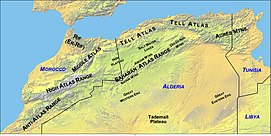
Back Groot-Atlas Afrikaans الأطلس الكبير Arabic Высокі Атлас Byelorussian Высокі Атляс BE-X-OLD Висок Атлас Bulgarian Alt Atles Catalan Haut Atlas CEB Vysoký Atlas Czech Atlas Uchel Welsh Høje Atlas Danish
This article includes a list of general references, but it lacks sufficient corresponding inline citations. (June 2008) |
| High Atlas | |
|---|---|
 | |
| Highest point | |
| Peak | Jbel Toubkal |
| Elevation | 4,167 m (13,671 ft) |
| Coordinates | 31°03′43″N 7°54′58″W / 31.06194°N 7.91611°W |
| Geography | |
 Location of the Atlas Mountains across North Africa
| |
| Country | Morocco |
| Range coordinates | 31°26′N 6°56′W / 31.433°N 6.933°W |
| Parent range | Atlas Mountain System |
The High Atlas, also called the Grand Atlas, is a mountain range in central Morocco, North Africa, the highest part of the Atlas Mountains.
The High Atlas rises in the west at the Atlantic Ocean and stretches in an eastern direction to the Moroccan-Algerian border. At the Atlantic and to the southwest the range drops abruptly and makes an impressive transition to the coast and the Anti-Atlas range. To the north, in the direction of Marrakech, the range descends less abruptly.
The range includes Jbel Toubkal, which at 4,167 m (2.589 mi; 13,671 ft) is the highest in the range and lies in Toubkal National Park. The range serves as a weather system barrier in Morocco running east–west and separating the Sahara from the Mediterranean and continental zones to the north and west. In the higher elevations of the massif, snow falls regularly, allowing winter sports. Snow lasts well into late spring in the High Atlas, mostly on the northern faces of the range. On the Western High Atlas, there is Oukaïmeden, one of three main ski stations in Morocco.
The High Atlas forms the basins for a multiplicity of river systems. The majority of the year-round rivers flow to the north, providing the basis for the settlements there. A number of wadis and seasonal rivers terminate in the deserts to the south and plateaux to the east of the mountains.
The High-Atlas Mountains are inhabited by Berbers, who live from agriculture and pastoralism in the valleys. In the steppe zone of the High-Atlas, where precipitations are low, the locals created a smart technique in managing the low precipitations and the weak soil. They turn the rather semi-arid lands into fertile valleys called locally by Agdal (garden in Berber). This technique has intrigued many Western agriculturalists, in which they were impressed by the high efficiency of this agricultural system. Many scientists, particularly French scientists, make yearly expeditions to observe the community and their living system.
© MMXXIII Rich X Search. We shall prevail. All rights reserved. Rich X Search